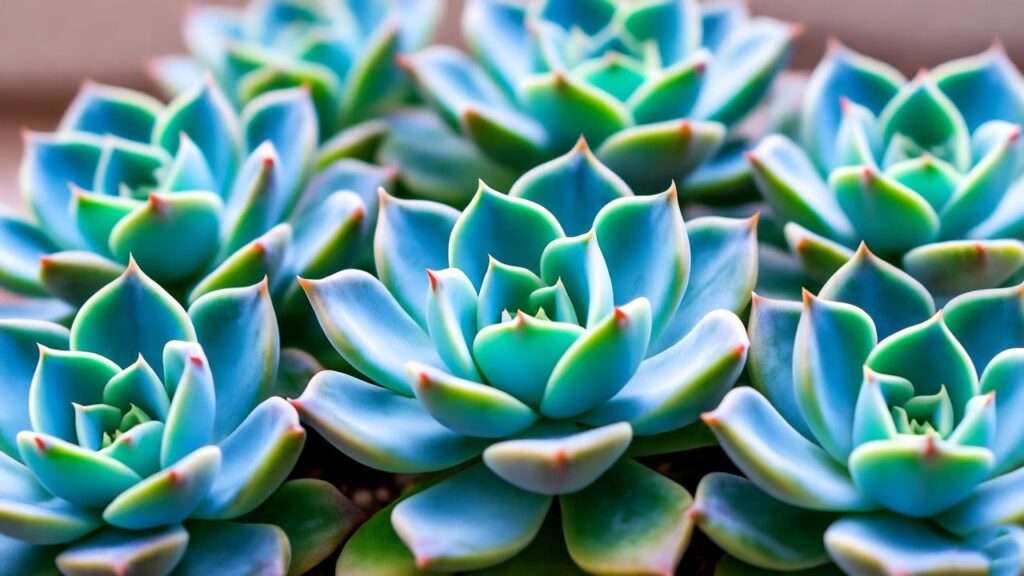Imagine transforming your home or garden with the mesmerizing hues of blue succulent plants! 🌿 These striking, low-maintenance beauties are stealing the spotlight in plant care circles, offering a unique blend of vibrant color and easy upkeep. Whether you’re a beginner or a seasoned plant enthusiast, mastering the care of blue succulents can elevate your space and bring joy to your gardening journey. In this comprehensive guide, we’ll dive into everything you need to know to grow and maintain these stunning plants, from selecting the perfect variety to troubleshooting common issues. Backed by over a decade of horticultural expertise, this article provides actionable, science-based tips to ensure your blue succulents thrive with vivid colors and robust health. Let’s get started! 🚀
What Are Blue Succulent Plants? 🌌
Blue succulent plants are a captivating group of drought-tolerant plants known for their bluish-green or true blue foliage. Their unique coloration often comes from a waxy, powdery coating called bloom or glaucous leaves, which protect them from harsh sunlight. These plants, including varieties like Echeveria ‘Blue Atoll,’ Senecio serpens, and Agave ‘Blue Glow,’ are prized for their aesthetic appeal and resilience.
Why Choose Blue Succulents?
Blue succulents are a favorite for both indoor and outdoor spaces due to their:
- Stunning Aesthetic: Their cool tones add a modern, calming vibe to any decor or garden.
- Low Maintenance: Perfect for busy plant owners, they require minimal watering and care.
- Versatility: They thrive in pots, terrariums, rock gardens, or xeriscapes.
Expert Insight: The blue hue is a natural adaptation to reflect intense sunlight, making these succulents ideal for arid environments or sunny windowsills.
Selecting the Right Blue Succulent for Your Space 🪴
Choosing the right blue succulent depends on your environment, aesthetic goals, and care commitment. Below, we explore popular varieties and their ideal settings.
Popular Blue Succulent Varieties
Here are some standout blue succulents to consider:
- Echeveria ‘Blue Atoll’: A rosette-forming succulent with soft, powdery blue leaves. Grows to 6 inches wide, perfect for indoor pots.
- Senecio serpens (Blue Chalksticks): Features slender, finger-like blue-green leaves. Ideal for ground cover in outdoor gardens.
- Agave ‘Blue Glow’: A striking, larger succulent with blue-green leaves edged in red. Best for outdoor landscapes in warm climates.
- Sedum ‘Blue Pearl’: Compact with vibrant blue foliage, great for small containers or mixed arrangements.
- Pachyphytum oviferum (Moonstones): Rounded, pale blue leaves resembling pebbles, ideal for indoor displays.
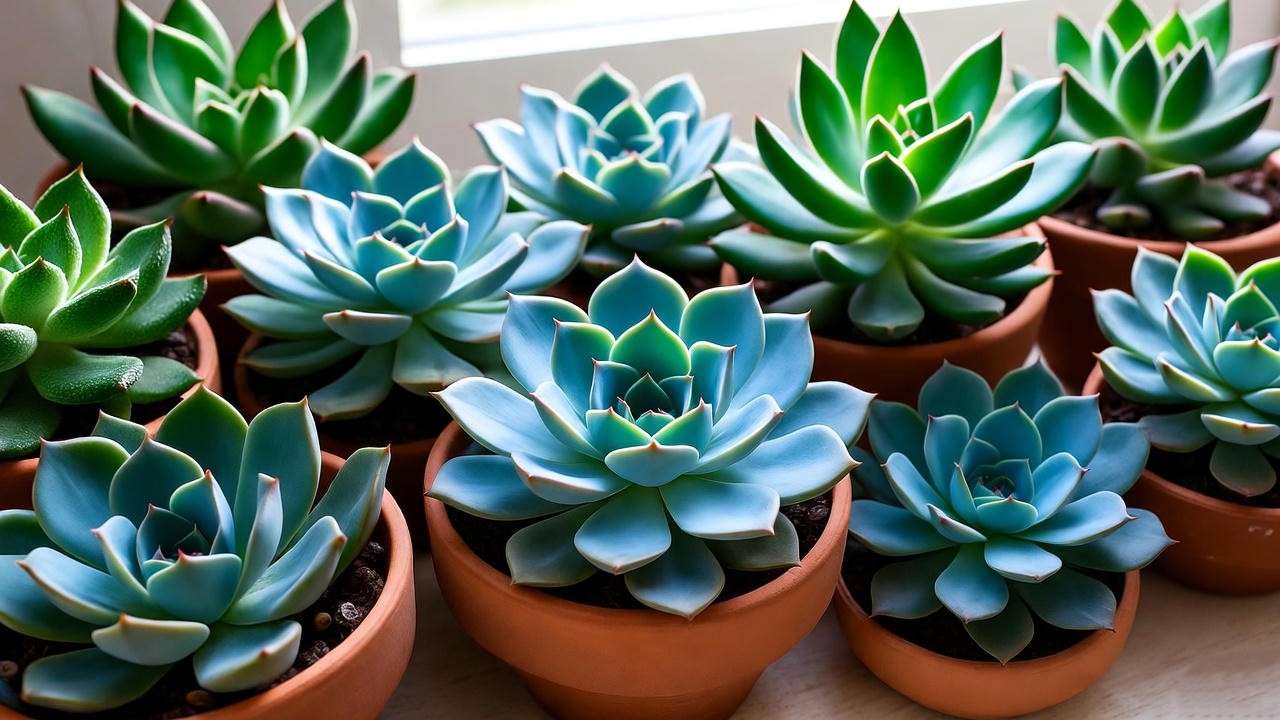
Indoor vs. Outdoor Blue Succulents
- Indoor Varieties: Echeveria ‘Blue Curls’ and Sedum ‘Blue Pearl’ thrive in bright, indirect light, making them perfect for windowsills or under grow lights.
- Outdoor Varieties: Senecio serpens and Agave ‘Blue Glow’ are hardy in USDA zones 9–11 and excel in sunny gardens or patios.
Tip: Use the table below to choose the best blue succulent for your needs.
| Variety | Size | Light Needs | Best For | Care Level |
| Echeveria ‘Blue Atoll’ | 6–8 inches | Bright, indirect | Indoor pots | Easy |
| Senecio serpens | 12 inches | Full sun | Outdoor ground | Easy |
| Agave ‘Blue Glow’ | 2–3 feet | Full sun | Outdoor gardens | Moderate |
| Sedum ‘Blue Pearl’ | 4–6 inches | Bright, indirect | Mixed containers | Easy |
| Pachyphytum oviferum | 4–6 inches | Bright, indirect | Indoor displays | Easy |
Essential Care Tips for Blue Succulent Plants ☀️
To keep your blue succulents thriving, focus on their core needs: light, water, soil, and temperature. Here’s how to get it right.
Light Requirements
Blue succulents need 6–8 hours of bright, indirect sunlight daily. For outdoor plants, partial shade works well in hot climates. Signs of improper light include:
- Too Little Light: Stretched, leggy growth or fading blue color.
- Too Much Light: Burnt or brown leaf tips.
Expert Tip: For indoor succulents in low-light areas, use a full-spectrum grow light (e.g., Sansi 36W LED Grow Light, $30–40) to mimic natural sunlight. Adjust the light to 12–14 hours daily for optimal growth.
Watering Blue Succulents
Overwatering is the number one killer of succulents. Use the “soak and dry” method:
- Water thoroughly until water drains from the pot’s holes.
- Allow the soil to dry completely before watering again (typically every 1–2 weeks).
- Reduce watering in winter when growth slows.
Common Mistake: Watering too frequently leads to root rot. Check soil moisture with a finger or moisture meter before watering.
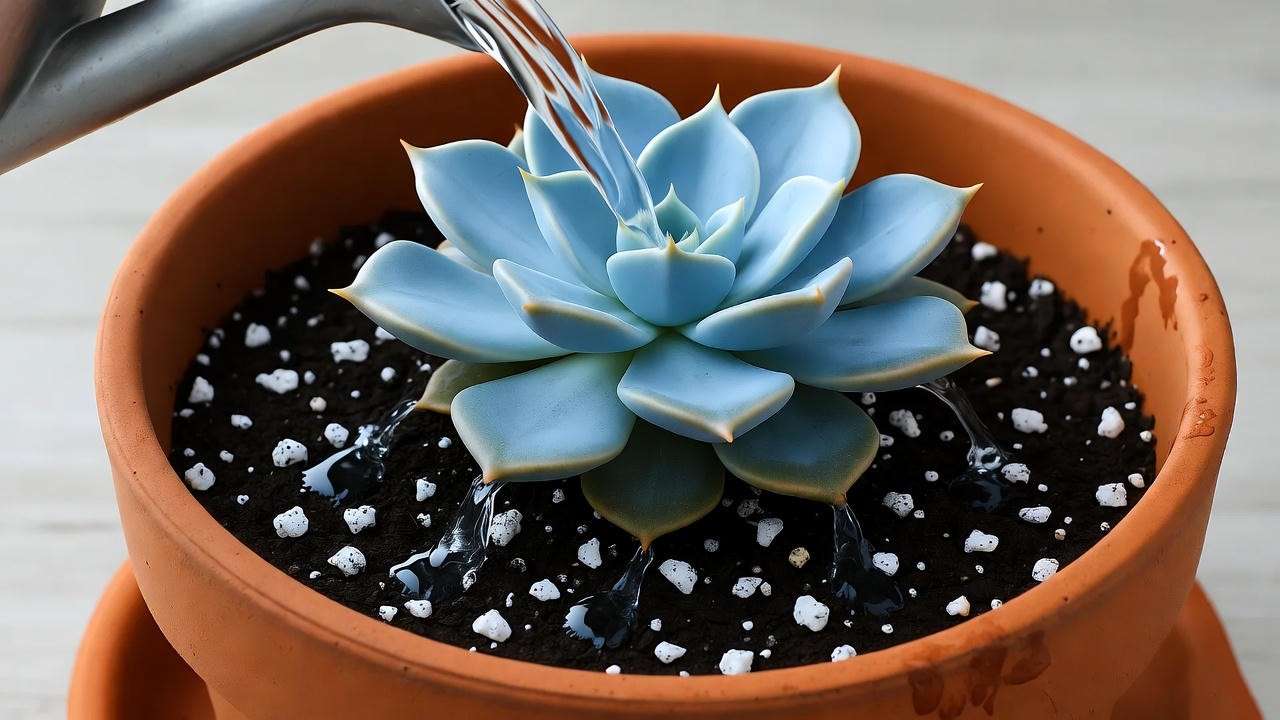
Soil and Potting Needs
Blue succulents require well-draining soil to prevent water retention. Use a cactus/succulent potting mix or create your own:
- DIY Soil Recipe: Mix 2 parts potting soil, 1 part coarse sand, and 1 part perlite or pumice.
- Pot Choice: Opt for terracotta or ceramic pots with drainage holes to promote airflow and prevent moisture buildup.
Temperature and Humidity
Blue succulents prefer temperatures between 60–80°F (15–27°C) and low to moderate humidity. Protect them from frost, as most varieties are not cold-hardy below 30°F (-1°C). In winter, bring outdoor succulents indoors or cover them with frost cloth in mild climates.
Winter Care Tip: Place indoor succulents near a south-facing window to maximize light during shorter days.
Maintaining Vibrant Blue Colors 🎨
The vivid blue hues of these succulents are their hallmark, but maintaining that color requires attention to specific factors.
Factors Affecting Color Intensity
The blue color is influenced by:
- Sunlight: Adequate light enhances the glaucous coating, deepening the blue hue.
- Stress: Controlled stress (e.g., slight drought or cooler nights) can intensify colors.
- Nutrients: Balanced fertilization supports vibrant foliage.
Science Behind the Blue: The glaucous coating is a waxy layer that reflects UV light, protecting the plant and creating its blue appearance. Too much water or shade can reduce this coating, dulling the color.
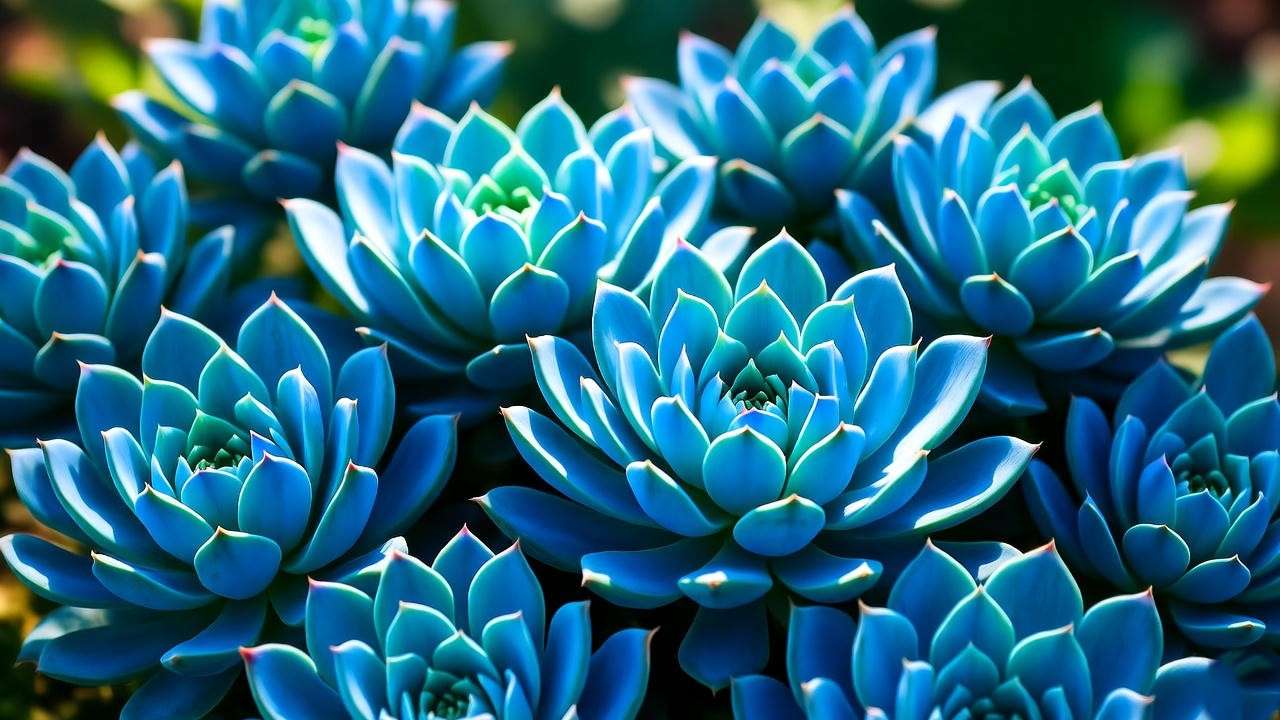
Fertilizing for Vibrancy
Fertilize sparingly to avoid lush, green growth that dilutes the blue hue:
- When: Monthly during spring and summer (growing season).
- What: Use a diluted, low-nitrogen fertilizer (e.g., 10-10-10 or a succulent-specific formula like Miracle-Gro Succulent Plant Food).
- Natural Alternative: Apply compost tea or worm castings for an organic boost.
Expert Insight: Over-fertilizing can cause succulents to lose their compact shape and vibrant color. Always dilute fertilizer to half-strength.
Propagating Blue Succulents: Grow Your Collection 🌱
Propagation is a cost-effective way to expand your blue succulent collection. Here are the most reliable methods.
Propagation Methods
- Leaf Cuttings:
- Gently twist a healthy leaf from the stem, ensuring a clean break.
- Let the leaf callous over for 1–2 days in a dry, shaded area.
- Place on well-draining soil and mist lightly every few days until roots form (2–4 weeks).
- Offsets/Pups:
- Identify small rosettes growing at the base of the parent plant.
- Use a clean knife to separate the pup, keeping some roots intact.
- Replant in a small pot with succulent soil and water sparingly.
- Stem Cuttings:
- Cut a healthy stem with a sharp, sterilized knife.
- Allow the cutting to callous for 2–3 days.
- Plant in well-draining soil and water after roots form (1–2 weeks).
Common Propagation Mistakes
- Overwatering: Keep soil barely moist to avoid rot.
- Impatience: Roots take time to develop; don’t disturb cuttings too soon.
- Poor Timing: Propagate in spring or early summer for best results.
Troubleshooting Tip: If a cutting fails to root, check for rot and try again with a healthier leaf or stem. Ensure proper callusing before planting.
Common Problems and Solutions 🩺
Blue succulent plants are generally hardy, but they can face challenges like pests, diseases, or environmental stress. Here’s how to identify and address common issues to keep your plants thriving.
Pests and Diseases
Common Pests:
- Mealybugs: White, cottony masses on leaves or stems. Treat with a cotton swab dipped in 70% isopropyl alcohol or apply neem oil weekly until gone.
- Aphids: Tiny green or black insects on new growth. Rinse with a strong stream of water or use insecticidal soap.
- Spider Mites: Fine webbing and speckled leaves. Increase humidity and spray with a neem oil solution.
Fungal Issues:
- Overwatering can lead to root rot or powdery mildew. Signs include mushy roots or white, powdery spots on leaves.
- Solution: Remove affected parts with a sterilized knife, improve drainage, and reduce watering. Apply a fungicide like sulfur for severe cases.
Prevention Tip: Regularly inspect your succulents and maintain good air circulation to deter pests and fungi.
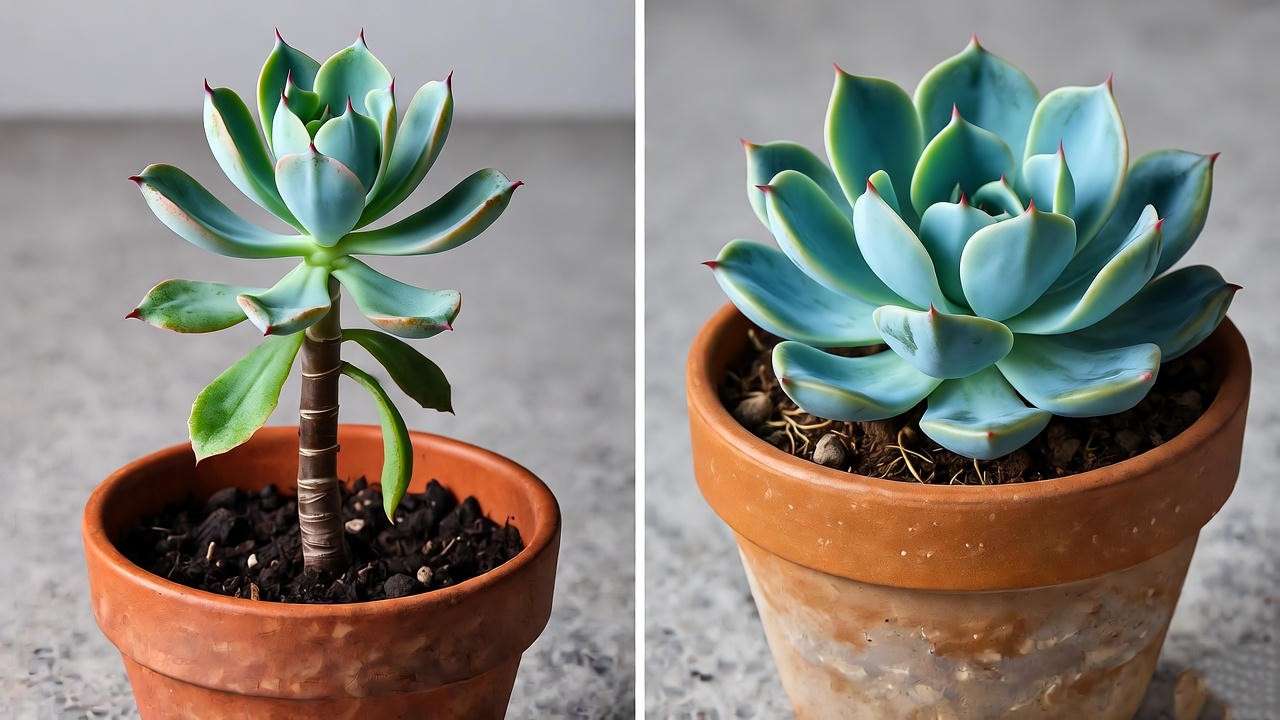
Troubleshooting Growth Issues
- Leggy Growth: Caused by insufficient light. Move the plant to a brighter location or supplement with a grow light (e.g., GE BR30 LED Grow Light, $15–20).
- Color Loss: Fading blue hues often indicate too much shade or overwatering. Adjust light exposure and let soil dry completely between waterings.
- Wilting: Can result from under- or overwatering. Check soil moisture and adjust your watering schedule accordingly.
Case Study: A reader shared their struggle with an overwatered Echeveria ‘Blue Atoll’ that turned soft and yellow. By removing soggy leaves, repotting in fresh, well-draining soil, and reducing watering to once every two weeks, the plant regained its vibrant blue hue within a month. Before/After Tip: Include images showing a wilted vs. revived succulent to illustrate recovery.
Designing with Blue Succulents: Aesthetic Tips 🖼️
Blue succulents are a designer’s dream, adding a cool, modern touch to any space. Here’s how to showcase their beauty indoors and outdoors.
Indoor Display Ideas
- Terrariums: Create a mini desert scene with blue succulents like Pachyphytum oviferum paired with decorative rocks and sand. Use open-top glass containers to ensure airflow.
- Pot Arrangements: Combine blue succulents with contrasting colors, like orange Echeveria ‘Afterglow’ or white Sedum ‘Frosty Morn,’ for a striking display.
- Vertical Gardens: Mount small blue succulents like Sedum ‘Blue Pearl’ on a wall planter for a living art piece.
Design Tip: Use neutral-colored pots (e.g., matte white or slate gray) to let the blue hues pop. Avoid overcrowding to prevent competition for light.
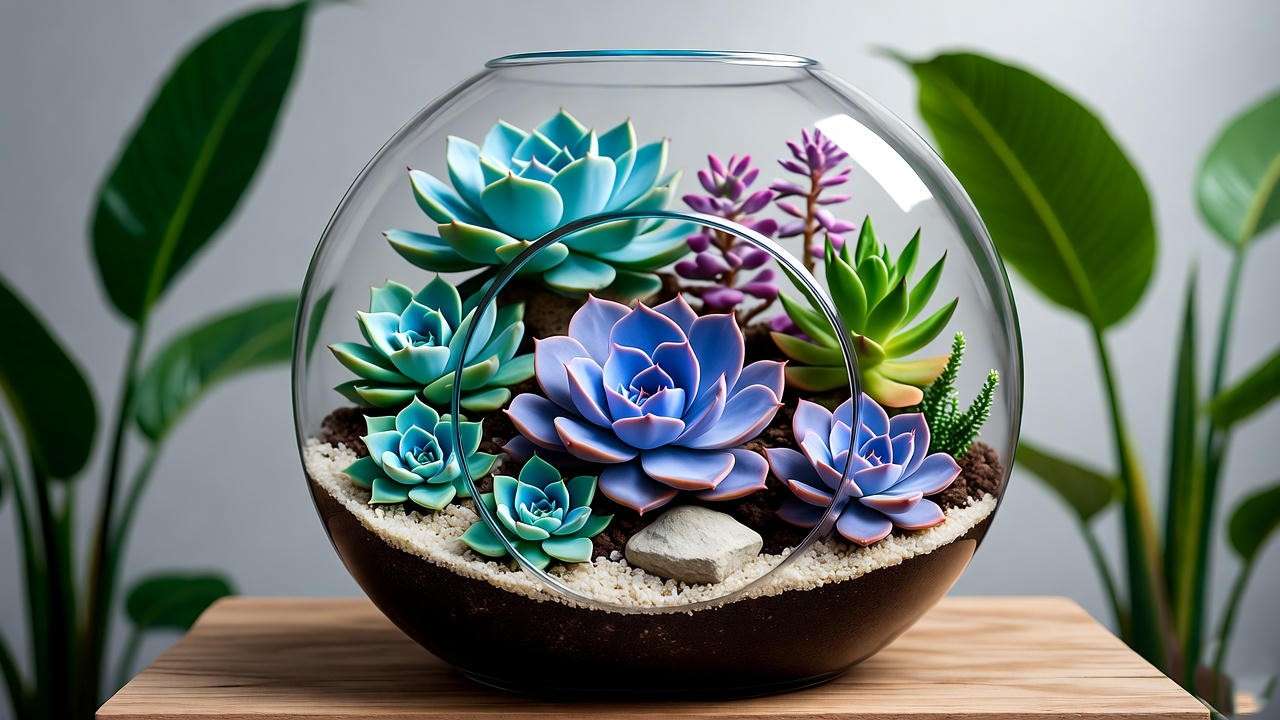
Outdoor Landscaping
- Rock Gardens: Plant Senecio serpens or Agave ‘Blue Glow’ among boulders for a low-maintenance, drought-tolerant landscape.
- Borders and Ground Cover: Use blue chalksticks as a spreading ground cover to define garden edges or fill gaps.
- Companion Plants: Pair with lavender, aloe, or red-tipped Echeveria for a vibrant, water-wise garden.
Visual Idea: Include a photo gallery of a rock garden featuring blue succulents with complementary plants like purple lavender and yellow Sedum ‘Angelina.’
Seasonal Care for Blue Succulents ❄️☀️
Blue succulents require slight adjustments in care based on the seasons to maintain their health and vibrancy.
Spring and Summer Care
- Watering: Increase frequency slightly (every 7–10 days) as plants enter their active growth phase, but always check soil dryness first.
- Light: Ensure maximum sunlight exposure, especially for outdoor plants. Move indoor succulents closer to windows or provide supplemental grow lights.
- Fertilizing: Apply a diluted succulent fertilizer monthly to support growth and color intensity.
Tip: Prune leggy growth in spring to encourage compact, rosette-shaped plants.
Fall and Winter Care
- Watering: Reduce to every 2–3 weeks as growth slows. Overwatering in winter is a common cause of root rot.
- Light: Maximize light exposure for indoor plants, as shorter days can reduce available sunlight. Rotate pots weekly for even growth.
- Temperature: Protect outdoor succulents from frost by moving them indoors or covering with frost cloth in zones below 9. Maintain indoor temperatures above 50°F (10°C).
Expert Insight: In winter, blue succulents may develop deeper colors due to cooler nights, mimicking their natural “stress” response. Embrace this as a natural enhancement of their beauty.
FAQs About Blue Succulent Plants ❓
To address common reader queries and boost SEO, here are answers to frequently asked questions about blue succulents.
Q: Why is my blue succulent turning green?
A: This is often due to insufficient light or overwatering. Move the plant to a brighter spot (6–8 hours of indirect sunlight) and ensure the soil dries out completely between waterings.
Q: Can blue succulents survive indoors year-round?
A: Yes, with proper care! Provide bright, indirect light, well-draining soil, and minimal watering. A grow light can help in low-light environments.
Q: How often should I fertilize my blue succulents?
A: Fertilize monthly during spring and summer with a diluted, low-nitrogen fertilizer. Avoid fertilizing in fall and winter to prevent overgrowth.
Q: Are blue succulents pet-safe?
A: Most blue succulents, like Echeveria and Sedum, are non-toxic to pets. However, Agave species may have sharp edges or mild toxins, so keep them out of reach of curious pets.
Q: How can I make my blue succulents bluer?
A: Increase sunlight exposure, reduce watering slightly, and apply controlled stress (e.g., cooler nights or less frequent watering) to enhance the glaucous coating.
Conclusion
Blue succulent plants are a stunning, low-maintenance addition to any plant lover’s collection, offering vibrant colors and endless design possibilities. 🌵 By following this expert-backed guide, you can master their care, from selecting the perfect variety to maintaining their vivid blue hues. Whether you’re creating a chic indoor display or a drought-tolerant outdoor garden, these tips ensure your blue succulents thrive year-round. Start your journey today—experiment with propagation, troubleshoot issues confidently, and let these unique plants transform your space. Have a question or success story? Share it in the comments below! 🌿
Call to Action: Ready to grow your own blue succulents? Visit your local nursery or explore trusted online retailers like Mountain Crest Gardens for healthy, vibrant plants. Happy planting! 🚀

